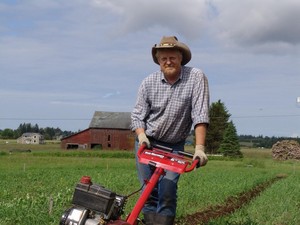23 Oct Fri 2009
Squash & Pumpkin Seeds for Vegans
Last Sunday at a seed swap event, I got a new angle on squash and pumpkin seeds. I eat them all the time and I usually toast them with salt and chili powder. Whenever I bake a squash, I clean the seeds and put them on a baking pan on a shelf directly under the baking squash sections. They only need half an hour or so. The new angle on squash is they are also a good protein source for vegans. I'm not a vegan, but a couple of my customers are, so I am always looking for vegan tips. Here's a list of some sources of protein, calcium and iron for vegans. The source is http://yourtotalhealth.ivillage.com/diet-fitness/stocking-vegans-pantry.html
Vegan sources of protein:
-
Brewer's yeast
-
Nuts
-
Nut butters
-
Soy products, especially TVP, tofu, soy nuts, soy milk and baked goods made with soy flour
-
Pumpkin and squash seeds
-
Legumes
-
Whole grains, especially quinoa, spelt and brown rice
Vegan sources of calcium:
-
Almonds
-
Filberts
-
Kale
-
Collards
-
Tofu
-
Broccoli
-
Bok choi
-
Turnip greens
-
Okra
Vegan sources of iron:
-
Cooking in iron skillets
-
Brewer's yeast
-
Pumpkin and squash seeds
-
Blackstrap molasses
-
Soybeans
-
Wheat germ
-
Pine nuts
-
Dried lima beans
-
Potatoes with their skin on
-
Dried raisins, prunes, apricots
Vegan sources of vitamin B12:
-
Fortified cereal and beverages
Snacks that make good and tasty use of these foods include:
-
Trail mix made with fortified cereal, pumpkin seeds, raisin and peanuts
-
Muffins made with wheat germ, soy flour and sweetened with molasses (only use a little, as blackstrap is a strong and bitter molasses that may overpower the muffin if used in excess)
-
Tofu cubes
Squash is quite easy to grow, as you can dig out a hill to plant them every six feet and space your rows six feet apart. You can even just slot them into your landscaping wherever you have some room and you don't mind the vines. You don't have to till if you don't want, but you do have to control the grass. If you like, you can cover the ground with heavy mulch until the vines grow up enough to crawl all over and take over your mulching duties for you. It is good to keep a 18-inch circle bare until the plants are up, to make sure the ground is warm. This is not hard to weed by hand. Around here (NW Washington) we can direct seed both summer and winter squash around mid-May. Some people with greenhouses start squash inside to get an extra jump on the weather. I don't bother. My favorite squash is Buttercup and I have my own variety, which resulted from a favorable mutation I discovered several years ago. It has orange flames that lick up the side of the dark green background. It is quite striking and I call it Flame Buttercup. I also grow Butternut, which I like in soups, and Hubbard, which I think has the best seeds of the squashes I have tried. Pumpkin seeds are even better and some pumpkins are grown just for their seeds. I think that's a good idea. Since summer squash (including zucchini) are Cucurbita pepo, like pie pumpkins, you could grow them out to maturity and eat their seeds too. Carving pumpkins are usually Cucurbita maxima, but you could certainly eat their seeds too. You have to be careful of crossing between varieties of the same species, so isolation of a quarter mile is preferred, but you could certainly plant C. maxima in with C. pepo. As I have mentioned before, squash was one of the earliest domesticates, for good reasons. Growing them as a seed source is another of their beneficial aspects.

